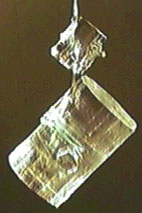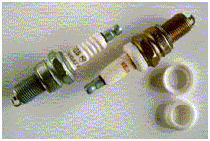 Another ignition source is the piezoelectric effect, though this also
has many other important applications. Piezoelectricity was discovered
in 1880 by Pierre and Paul-Jacques Curie, they found that when they compressed
certain types of crystals, including quartz and Rochelle salt (potassium sodium tartrate tetrahydrate), along certain axes, a voltage
was produced on the surface of the crystal. This effect is only observed
in crystals whose unit cells do not have a centre of symmetry, e.g. the
zinc blende form of ZnS. When the crystal is stressed its structure distorts,
and if the structure is asymmetrical a charge separation develops and a
potential difference is generated. The voltage may be discharged as a spark,
and the spark used as an ignition source. This form of ignition is found
in modern gas ovens and gas lighters.
Another ignition source is the piezoelectric effect, though this also
has many other important applications. Piezoelectricity was discovered
in 1880 by Pierre and Paul-Jacques Curie, they found that when they compressed
certain types of crystals, including quartz and Rochelle salt (potassium sodium tartrate tetrahydrate), along certain axes, a voltage
was produced on the surface of the crystal. This effect is only observed
in crystals whose unit cells do not have a centre of symmetry, e.g. the
zinc blende form of ZnS. When the crystal is stressed its structure distorts,
and if the structure is asymmetrical a charge separation develops and a
potential difference is generated. The voltage may be discharged as a spark,
and the spark used as an ignition source. This form of ignition is found
in modern gas ovens and gas lighters.
 Devices were also invented as a specialized and controllable ignition
source for systems, such as the spark plug in a car. The spark plug was
invented by Robert Bosch and is a device that fits into the cylinder head
of an internal-combustion engine. The spark plug is composed of two electrodes
separated by an air gap, across which current from a high-tension ignition
system discharges, to form a spark for fuel ignition. Spark-gap length
affects the energy of the spark, and the shape of the insulator affects
the temperature of operation.
Devices were also invented as a specialized and controllable ignition
source for systems, such as the spark plug in a car. The spark plug was
invented by Robert Bosch and is a device that fits into the cylinder head
of an internal-combustion engine. The spark plug is composed of two electrodes
separated by an air gap, across which current from a high-tension ignition
system discharges, to form a spark for fuel ignition. Spark-gap length
affects the energy of the spark, and the shape of the insulator affects
the temperature of operation.
Back to the Welcome Page